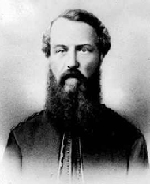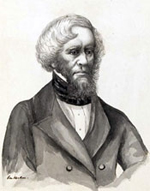EARLY CHURCHES
| The Spanish took over Port Louis renaming it Puerto de la Soledad in 1767 and remained there until 1810. While they were there it is known that 57 different Catholic military priests served around 200 settlers there and two churches were built, the first just after their arrival, primitive and of turf but could hold up to 100 people, and the second more substantial and made of stone in 1801. |
The first Church in Stanley
From 1844 settlers from Port Louis relocated to Stanley, the new seat of British Government under Governor Moody. As there was no church or chaplain Moody himself led services in a dockyard building, the settlers being called to service by a large ship’s bell set on an old ship’s spar around 35 ft high. Moody’s brother James was appointed Colonial chaplain in 1845 and £100 was set aside for construction of a church. The 1851 census records a population of 372, roughly half of them being Catholic. By 1847 a wooden building was built on the site of the now Speedwell Store on the corner between Villiers and John Street. This was intended for the purpose of church and school and consisted of 4 rooms, a loft and two small lobbies. The room that served for the first church and school in Stanley was just 18ft x 27.5ft. It contained a slate mantelpiece, six narrow benches, two long and two short benches and a temporary pulpit covered with red baise. There was a piece of Kidderminster carpet at the West end, on which the Communion Table was placed. The second room served as a hospital with a small portion of it partitioned off as a Vestry. In 1855 the Church and hospital were combined to make one large 42ft x 18ft room; this was used for Divine Service on Sundays and served as a school through the week. When Governor Rennie arrived in the islands in 1848 he found the idea of a church being also used as a hospital and dispensary objectionable and it was converted to just a church, complete with a pulpit. |
Holy Trinity Church
Governor George Rennie (Governor of the islands 1848-1855) did much to try to bring order and purpose to the young own of Stanley. The people of the town were living on rations and provisions handed out from the Government Stores. There was no milk or butter in a colony who at that time had thousands of cattle. Rennie led by example buying and domesticating a cow successfully and settlers followed suit. He himself had brought garden seeds for vegetables and they were found to grow well there. A General Improvement Society was formed encouraging settlers to raise animals and vegetables. This was resulted in an abundance of food in the town, the people were no longer reliant on rations from Government. Rennie proposed a public building or market place should be built near to the sea where surplus produce could be sold to shipping. The settlers were well placed and able to cash in on the 'Gold Rushes' starting in 1850 that brought ships to Stanley for fresh supplies of meat, vegetables and water and of course for repairs.
A covered market place with a clock tower known as the Exchange Building was completed 1854, intended as a commercial meeting place for ships masters and colonists. It stood on the site on which now stands Christ Church Cathedral. Directly opposite the tower projected a wooden jetty into the harbour from Ross Road. The building had a central tower and left and right wings. The Tower was around 55ft (16.76m) high and had three stories, the lower being an entrance hall (solid mahogany door) , the middle contained the 4ft (1.2m) diameter clock facing the Harbour and the top section contained the bell and striker of the clock. There were wooden shutters on this section instead of windows so that the striking of the clock could be heard.
The left wing of the main building formed one large 42ft x 17ft (12.8m x 5.18m) room with two fireplaces. The Governor and furniture from Government house temporarily occupied this wing. The right wing was divided by wooden partitions into rooms. From the hall a door led into a small ante- room with a fireplace. Out of this led to bed rooms. A door from the ante-room led into the passage to the kitchen. On one side of the passage was a staircase leading to the attics in the roof and a small room between the staircase and the kitchen. The upstairs was floored and partitioned into rooms and lit by sky-lights. The Exchange building was higher than the road so a retaining wall of masonry coped with York Stone was built in front of it.
In 1856 Governor Moore decreed that the east wing be used as a church and the west wing a school. A five octave organ from the ‘Allen Gardiner’ was accepted for the new church. The Governor, despite a petition from members of the community unwilling to support its upkeep, transferred responsibility for the east wing to the church and chaplain. Further representations to Governor Mackenzie in 1865 resulted in it again reverting to the government. After 1859 it was referred to as Holy Trinity Church in the Blue Books and after 1862 the building was called ‘Holy Trinity Church’ in the County of Ross’.
Bishop Sterling arrived in the Falklands on the 11th of January 1872 and was installed as Bishop on the 14th by Charles Bull the then colonial chaplain. Governor D’Arcy recommended that the building be again passed to the church. Bishop Sterling refused to consecrate it while half of it was being used as school. Thoughts turned to considering moving the school and building a new church. In 1877 the the Revered Lowther E. Brandon arrived to take up office. He fought intemperance, opened a children’s library and started a Penny Saving Bank. He also worked tirelessly for the camp not just the town.
On the wet and stormy night of June 2nd 1886 a second peat slip caused by the unstable peat workings close to Stanley caused much damage to the little town. Most people were indoors due to the bad weather and those in wrecked houses managed to escape. Two people died including a child as a stream of half liquefied peat over a hundred yards in width and 4 to 5ft (1.2-1.5m) deep flowed through the town and into the harbour. Streets were blocked and people imprisoned in their houses. Holy Trinity Church was one of the buildings badly damaged. The rear of the building and clock tower was beyond repair and the building was immediately and permanently declared unsafe for use. Services were taken in a sail loft. Holy Trinity was demolished and Christ Church Cathedral was to be built on the site, using stone from the destroyed building.
|
| |
Sources: The Falkland Islands and South America- Rev. C. McDonald Dobley 1917, The Falkland Islands- Ian J. Strange . |
    
|
|
| |
|
| |
 |
Lieutenant Richard Clement Moody. Governor 1842-1848. |
 |
Lieutentat George Rennie. Governor 1848-1855 |
| |
|
|
| |
|
|

 Stanley 1872, showing Holy Trinity Church before the peat slip of 1886
Stanley 1872, showing Holy Trinity Church before the peat slip of 1886